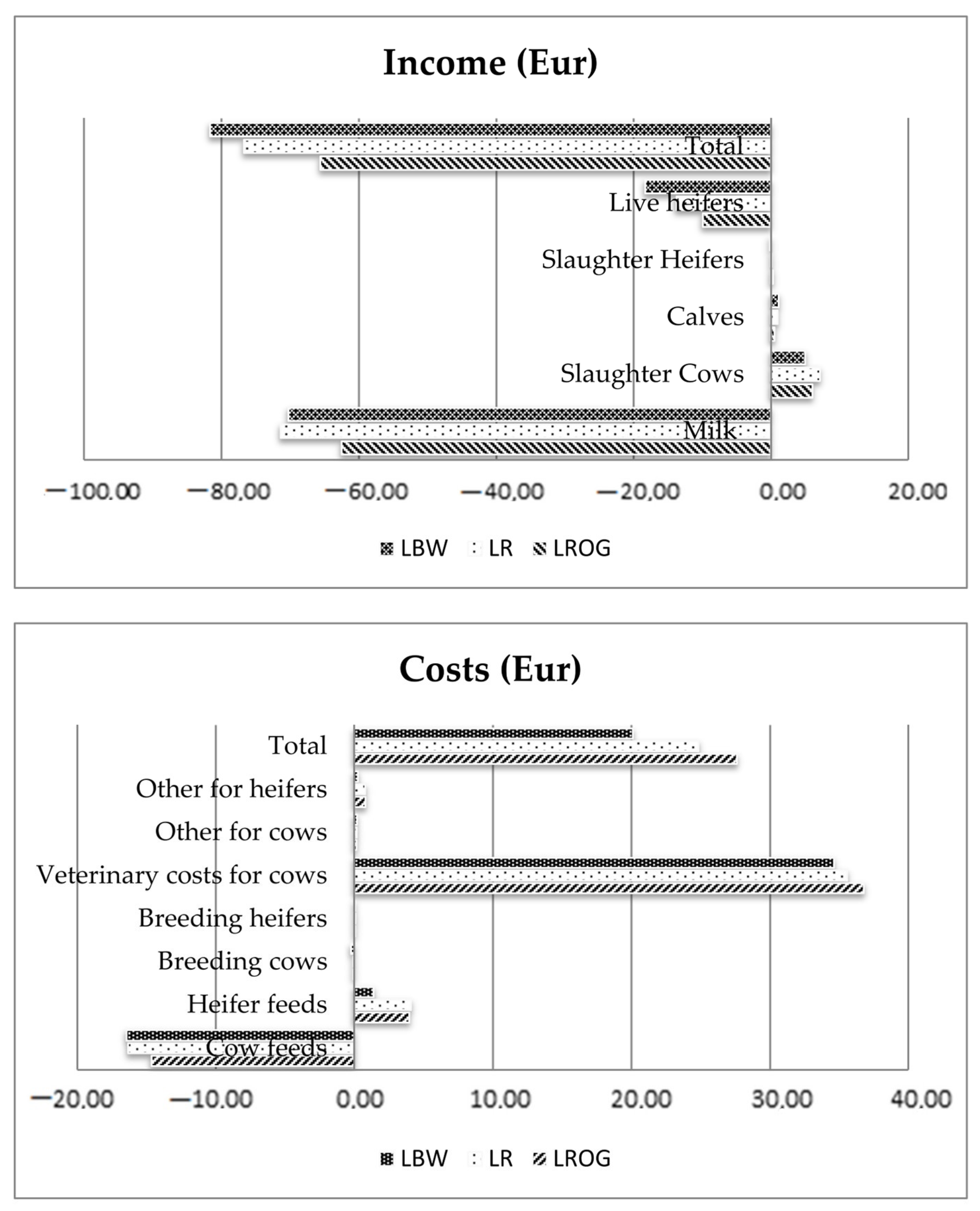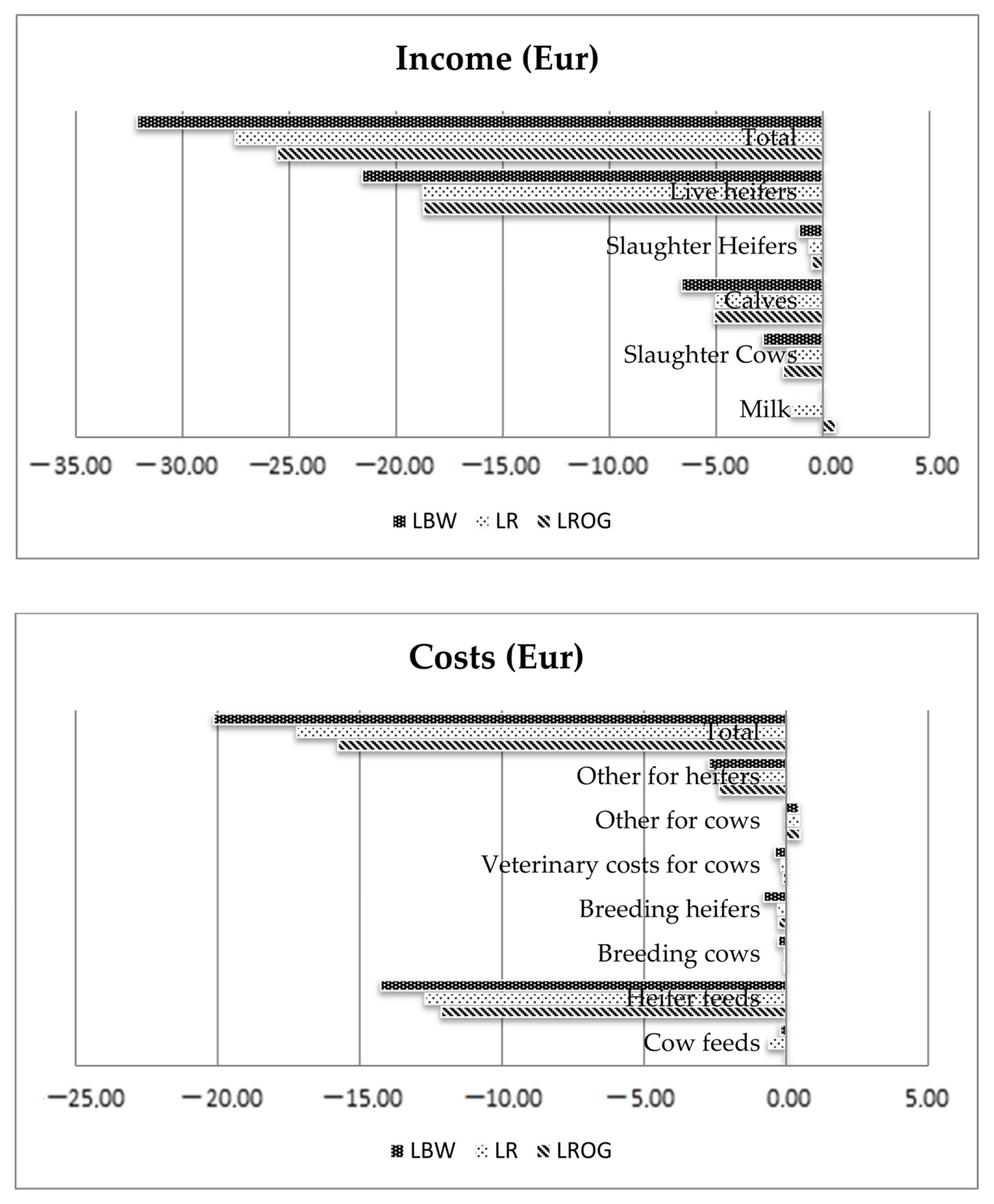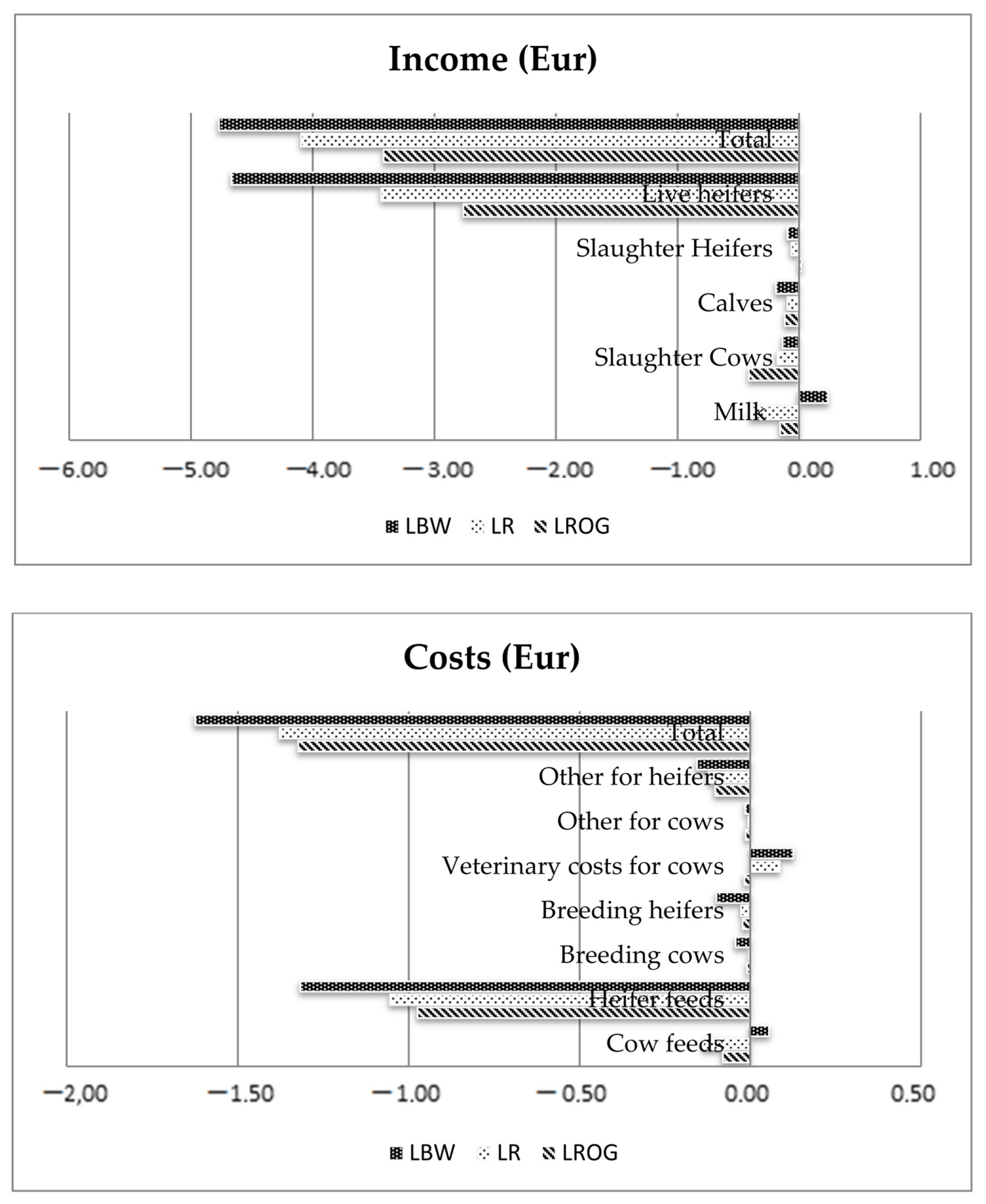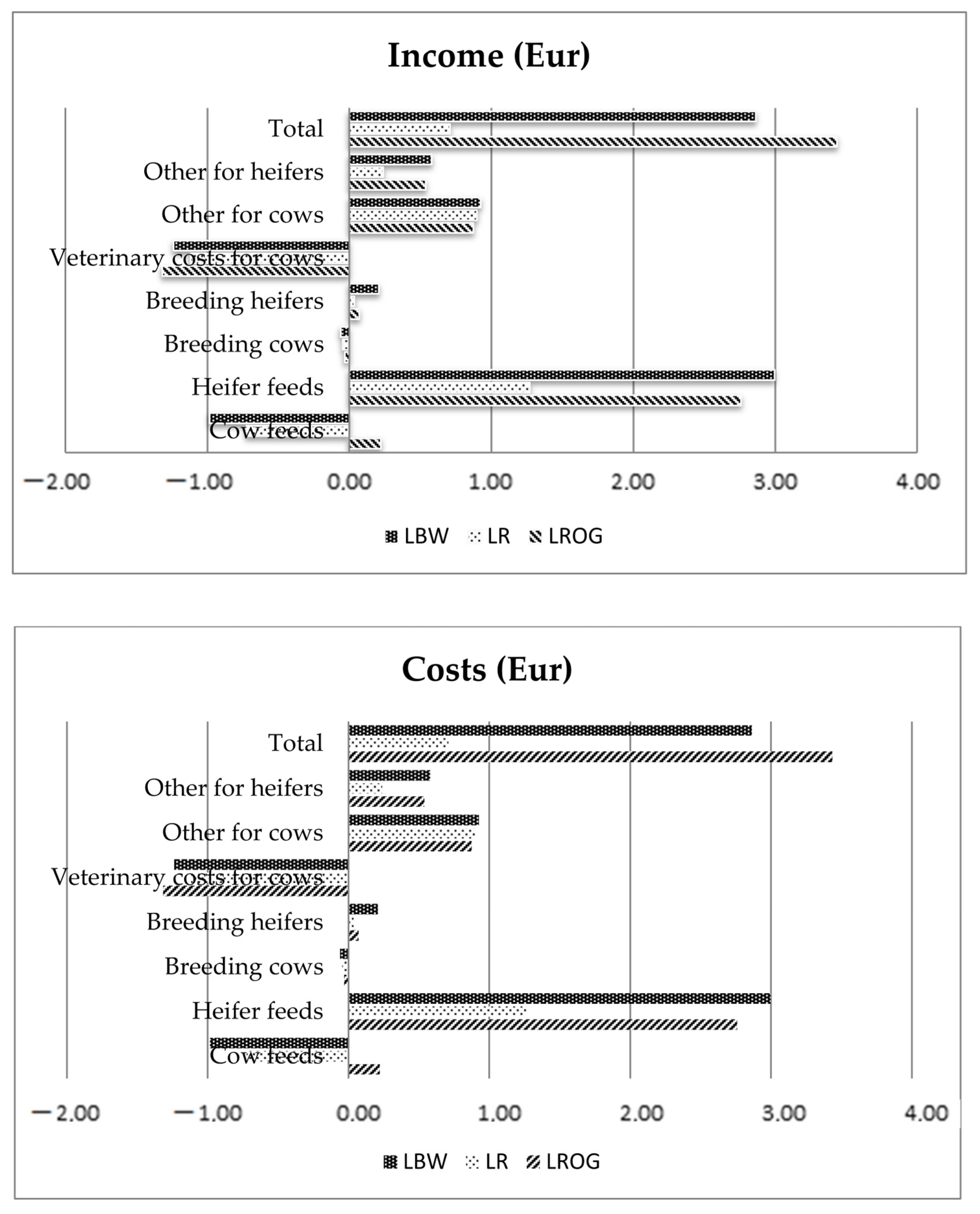Application of a Bio-Economic Model to Demonstrate the Importance of Health Traits in Herd Management of Lithuanian Dairy Breeds
Simple Summary
Abstract
1. Introduction
2. Materials and Methods
2.1. SimHerd–A Bio-Economic Model
2.2. Description of Traits
- Production. ECM (kg) was calculated on the basis of milk, fat and protein yield for LBW, LR and LROG. The study assumed that the lower use of concentrates for the LROG was due to lower yield.
- Health traits. EVs were estimated for the following diseases: mastitis related with udder health, lameness in relation to the health of claws and legs, ketosis and milk fever associated with metabolic health and metritis representing a reproductive disorder in dairy cattle.
- Reproduction traits. EVs were estimated for conception rate and insemination rate of both cows and heifers. Conception rate was the probability of a cow/heifer to become pregnant after insemination. The insemination rate of a cow/heifer was defined as the probability of a female to become pregnant after insemination.
- Calving traits. Calving traits were represented by dystocia and stillbirth. Dystocia was defined as the probability of a difficult calving with veterinary assistance. Stillbirth was defined as the proportion of dead calves within 48 h postpartum as an average of both primiparous and multiparous cows.
- Calf and cow survival traits. Calf survival (early and late) traits were represented by the probability of a calf dying in the period from 3 d to 14 d postpartum and 189 to 458 d postpartum, respectively. Cow mortality was represented as the probability of a cow dying due to a process not influenced by the health of the fertility problem.
2.3. Double Counting and Multiple Regression
2.4. Input Parameters for Model Calibration
3. Results
3.1. Herd Statistics: Income and Costs for Lithuanian Dairy Breeds
3.2. Economic Values
3.2.1. Economic Values of Production
3.2.2. Economic Values of Direct Health Traits
3.2.3. Economic values of Calving
3.2.4. Economic values of Calf survival
3.2.5. Economic Values of Cow Survival
4. Discussion
5. Conclusions
Author Contributions
Funding
Institutional Review Board Statement
Informed Consent Statement
Data Availability Statement
Conflicts of Interest
References
- Agricultural Information and Rural Business Centre. Annual Report of Milk Recording of Lithuanian Breeds 2019–2020; Ministry of Agriculture of the Republic of Lithuania: Vilnius, Lithuania, 2020. [Google Scholar]
- Razmaitė, V.; Šveistienė, R.; Macijauskienė, V.; Zapasnikienė, B.; Janušonis, S.; Juodka, R.; Benediktavičiūtė-Kiškienė, A.; Ribikauskienė, D. Farm Animal Breeds in Lithuania; LVA Gyvulininkystės Institutas: Baisogala, Lietuva, 2007; pp. 18–22. [Google Scholar]
- Petraitis, J. Veislės Sudarymo Procesas Ir Biologinės Savybės. Lietuvos Žalieji Galvijai; Mintis: Vilnius, Lithuania, 1966; p. 255. [Google Scholar]
- Urbšienė, D.; Urbšys, A. Automatizuotas Melžimo Sistemas Bei Elektroninius Pieno Matuoklius Naudojančių Ūkių Kontroliuojamų Karvių Produkcijos Apskaitos Optimizavimas. Galutinė Ataskaita; LSMU Gyvulininkystės Institutas: Baisogala, Lietuva, 2014; Available online: https://zum.lrv.lt/uploads/zum/documents/files/LT_versija/Veiklos_sritys/Mokslas_mokymas_ir_konsultavimas/Moksliniu_tyrimu_ir_taikomosios_veiklos_darbu_galutines_ataskaitos/4darbas2014.pdf (accessed on 25 November 2021).
- Rauw, W.M.; Kanis, E.; Noordhuizen-Stassen, E.N.; Grommers, F.J. Undesirable side effects of selection for high production efficiency in farm animals: A review. Livest. Prod. Sci. 1998, 56, 15–33. [Google Scholar] [CrossRef]
- Windig, J.J.; Calus, M.P.L.; Beerda, B.; Veerkamp, R.F. Genetic Correlations Between Milk Production and Health and Fertility Depending on Herd Environment. J. Dairy Sci. 2006, 89, 1765–1775. [Google Scholar] [CrossRef]
- Nielsen, H.M.; Groen, A.F.; Østergaard, S.; Berg, P. A stochastic model for the derivation of economic values and their standard deviations for production and functional traits in dairy cattle. Acta Agric. Scand. A Anim. Sci. 2006, 56, 16–32. [Google Scholar] [CrossRef]
- Pfeiffer, C.; Fuerst-Waltl, B.; Schwarzenbacher, H.; Steininger, F.; Fuerst, C. A comparison of methods to calculate a total merit index using stochastic simulation. Genet 2015, 47, 36. [Google Scholar] [CrossRef]
- Kargo, M.; Hjortø, L.; Toivonen, M.; Eriksson, J.A.; Aamand, G.P.; Pedersen, J. Economic basis for the Nordic Total Merit Index. J. Dairy Sci. 2014, 97, 7879–7888. [Google Scholar] [CrossRef]
- Brito, L.F.; Bedere, N.; Douhard, F.; Oliveira, H.R.; Arnal, M.; Peñagaricano, F.; Schinckel, A.P.; Baes, C.F.; Miglior, F. Review: Genetic selection of high-yielding dairy cattle toward sustainable farming systems in a rapidly changing world. Animal 2021, 15, 100292. [Google Scholar] [CrossRef]
- Østergaard, S.; Ettema, J.F.; Hjortø, L.; Pedersen, J.; Lassen, J.; Kargo, M. Avoiding double counting when deriving economic values through stochastic dairy herd simulation. Livest. Sci. 2016, 187, 114–124. [Google Scholar] [CrossRef]
- Wolfová, M.; Wolf, J. Strategies for defining traits when calculating economic values for livestock breeding: A review. Animal 2013, 7, 1401–1413. [Google Scholar] [CrossRef]
- Schmidtmann, C.; Thaller, G.; Kargo, M.; Hinrichs, D.; Ettema, J. Derivation of economic values for German dairy breeds by means of a bio-economic model—With special emphasis on functional traits. J. Dairy Sci. 2021, 104, 3144–3157. [Google Scholar] [CrossRef]
- Cainzos, J.M.; Andreu-Vazquez, C.; Guadagnini, M.; Rijpert-Duvivier, A.; Duffield, T. A systematic review of the cost of ketosis in dairy cattle. J. Dairy Sci. 2022, 105, 6175–6195. [Google Scholar] [CrossRef]
- Juozaitiene, V.; Juozaitis, A.; Kardisauskas, A.; Zymantiene, J.; Zilaitis, V.; Antanaitis, R.; Ruzauskas, M. Relationship between dystocia and the lactation number, stillbirth and mastitis prevalence in dairy cows. Acta Vet. Brno 2017, 86, 345–352. [Google Scholar] [CrossRef][Green Version]
- Enting, H.; Kooij, D.; Dijkhuizen, A.A.; Huirne, R.B.M.; Noordhuizen-Stassen, E.N. Economic losses due to clinical lameness in dairy cattle. Livest. Prod. Sci. 1997, 49, 259–267. [Google Scholar] [CrossRef]
- Agricultural Information and Rural Business Centre. Breeding Value. Available online: http://archyvas.vic.lt/?module=breed_value (accessed on 20 March 2022).
- Østergaard, S.; Chagunda, M.G.G.; Friggens, N.C.; Bennedsgaard, T.W.; Klaas, I.C. A stochastic model simulating pathogen-specific mastitis control in a dairy herd. J. Dairy Sci. 2005, 88, 4243–4257. [Google Scholar] [CrossRef]
- Ettema, J.F.; Østergaard, S. Economic decision making on prevention and control of clinical lameness in Danish dairy herds. Livest. Sci. 2006, 102, 92–106. [Google Scholar] [CrossRef]
- Ettema, J.F.; Østergaard, S.; Sørensen, M.K. Effect of including genetic progress in milk yield on evaluating the use of sexed semen and other reproduction strategies in a dairy herd. Animal 2011, 5, 1887–1897. [Google Scholar] [CrossRef]
- Kosińska-Selbi, B.; Schmidtmann, C.; Ettema, J.F.; Szyda, J.; Kargo, M. Breeding goals for conservation and active Polish dairy cattle breeds derived with a bio-economic model. Livest. Sci. 2022, 255, 104809. [Google Scholar] [CrossRef]
- Clasen, J.B.; Kargo, M.; Fikse, W.F.; Strandberg, E.; Wallenbeck, A.; Østergaard, S.; Rydhmer, L. Conservation of a native dairy cattle breed through terminal crossbreeding with commercial dairy breeds. Acta Agric. Scand. Sect. A—Anim. 2021, 70, 1–12. [Google Scholar] [CrossRef]
- Antanaitis, R.; Žilaitis, V.; Kučinskas, A.; Juozaitienė, V.; Leonauskaitė, K. Changes in cow activity, milk yield, and milk conductivity before clinical diagnosis of ketosis, and acidosis. Vet. Med. Zoot. 2015, 70, 1392–2130. Available online: https://vetzoo.lsmuni.lt/data/vols/2015/70/pdf/antanaitis.pdf (accessed on 25 January 2022).
- Agricultural Information and Rural Business Centre. Annual Report of Milk Recording of Lithuanian Breeds 2016–2017, No 80; Ministry of Agriculture of the Republic of Lithuania: Vilnius, Lithuania, 2017. [Google Scholar]
- Juozaitienė, V. Genetic Evaluation Model of Calf Mortality and General Calving Creating an Index of Features; Lithuanian University of Health Science: Kaunas, Lithuania, 2015; Available online: https://zum.lrv.lt/uploads/zum/documents/files/LT_versija/Veiklos_sritys/Mokslas_mokymas_ir_konsultavimas/Moksliniu_tyrimu_ir_taikomosios_veiklos_darbu_galutines_ataskaitos/LSMU%20verseliu%20mirtingumas.pdf (accessed on 25 January 2021).
- Sørensen, L.P.; Pedersen, J.; Kargo, M.; Nielsen, U.S.; Fikse, F.; Eriksson, J.Å.; Pösö, J.; Stephansen, R.S.; Aamand, G.P. Review of Nordic Total Merit Index Full Report November 2018. Available online: https://nordicebv.info/reports/ (accessed on 25 January 2021).
- Egger-Danner, C.; Cole, J.B.; Pryce, J.E.; Gengler, N.; Heringstad, B.; Bradley, A.; Stock, K.F. Invited review: Overview of new traits and phenotyping strategies in dairy cattle with a focus on functional traits. Animal 2015, 9, 191–207. [Google Scholar] [CrossRef]
- Krupová, Z.; Krupa, E.; Michaličková, M.; Wolfová, M.; Kasarda, R. Economic values for health and feed efficiency traits of dual-purpose cattle in marginal areas. J. Dairy Sci. 2016, 99, 644–656. [Google Scholar] [CrossRef]
- Halasa, T.; Huijps, K.; Østerås, O.; Hogeveen, H. Economic effects of bovine mastitis and mastitis management: A review. Vet. Q. 2007, 29, 18–31. [Google Scholar] [CrossRef]
- Koeck, A.; Miglior, F.; Kelton, D.F.; Schenkel, F.S. Short communication: Genetic parameters for mastitis and its predictors in Canadian Holsteins. J. Dairy Sci. 2012, 95, 7363–7366. [Google Scholar] [CrossRef]
- Griffiths, B.E.; White, D.G.; Oikonomou, G. A Cross-Sectional Study Into the Prevalence of Dairy Cattle Lameness and Associated Herd-Level Risk Factors in England and Wales. Front. Vet. Sci. 2018, 5, 65. [Google Scholar] [CrossRef]
- Ozsvari, L. Economic Cost of Lameness in Dairy Cattle Herds. J. Dairy Vet. Anim. Res. 2017, 6, 283–289. [Google Scholar] [CrossRef]
- Bazer, F.; Lamb, G.C.; Wu, G. Animal Agricultur. Sustainability, Challenges and Innovations; Academic Press: Cambridge, MA, USA, 2019; Available online: https://www.elsevier.com/books/T/A/9780128170526 (accessed on 15 February 2022)ISBN 9780128170533.
- Mahnani, A.; Sadeghi-Sefidmazgi, A.; Keshavarzi, H. Performance and financial consequences of stillbirth in Holstein dairy cattle. Animal 2018, 3, 617–623. [Google Scholar] [CrossRef]
- Santman-Berends, I.M.G.A.; Schukken, Y.H.; Van Schaik, G. Quantifying calf mortality on dairy farms: Challenges and solutions. J. Dairy Sci. 2019, 102, 6404–6417. [Google Scholar] [CrossRef]
- Miglior, F.; Fleming, A.; Malchiodi, F.; Brito, L.F.; Martin, P.; Baes, C.F. A 100-year review: Identification and genetic selection of economically important traits in dairy cattle. J. Dairy Sci. 2017, 100, 10251–10271. [Google Scholar] [CrossRef] [PubMed]
- Juškiene, V.; Šveistiene, R.; Marašinskiene, Š.; Nyman, S. Phenotypic recording of dairy cattle. Interbull 2021, 1–16. Available online: https://interbull.org/static/web/Rediverse_countries_report_phenotypic_information.pdf (accessed on 12 February 2022).




| 1. | 2. | 3. |
|---|---|---|
| Lithuanian Black-and-White cattle open population (LBW) | Lithuanian Red cattle open population (LR) | Lithuanian Red cattle old genotype (LROG) |
| Simherd—mechanistic, dynamic and stochastic dairy herd model Monte Carlo model prediction of the production and states of the herd time | ||
| 2 STEPS: | ||
| 1. INPUT DATA: | 2. OUTPUT DATA: | |
Parameter values for relations in the model:
| Technical annual results:
| |
| Trait | Traits Used as Mediator Variables |
|---|---|
| Mastitis | Milk yield Cow mortality |
| Metritis | Milk yield Ketosis Cow conception rate Cow insemination rate |
| Ketosis | Milk yield Cow conception rate |
| Milk fever | Milk yield Metritis Mastitis Dystocia |
| Lameness | Milk yield Cow conception rate Cow mortality |
| Dystocia | Stillbirth Cow mortality |
| Item | LBW | LR | LROG |
|---|---|---|---|
| Fat% | 4.31 | 4.43 | 4.56 |
| Protein % | 3.35 | 3.50 | 3.48 |
| 1st lactation. kg ECM * | 6741 | 6907 | 4916 |
| 2nd lactation. kg ECM * | 7648 | 7596 | 5553 |
| 3rd lactation. kg ECM * | 7526 | 7469 | 5949 |
| Trait | LBW | LR | LROG |
|---|---|---|---|
| Calving interval [days] | 424 | 412 | 421 |
| Age at 1st calving [months] | 27.2 | 25.8 | 24.6 |
| Heat observation rate cows [%] | 43.16 | 45.16 | 45.24 |
| Heat observation rate heifers [%] | 59.91 | 55.08 | 55.56 |
| Conception rate cows [%] | 50 * | 45 * | 50 ** |
| Conception rate heifers [%] | 62.5 * | 58.82 * | 62.5 |
| Start breeding [days] | 44.27 | 46.67 | 45.62 |
| Disease | Breed | ||
|---|---|---|---|
| LBW | LR | LROG | |
| Stillbirth * | 6.5 | 5.2 | - |
| Milk fever ** | 3.5 | 3.5 | 3.5 |
| Dystocia ** | 1.3 | 1.3 | 1.3 |
| Metritis ** | 8.0 | 7.0 | 7.0 |
| Ketosis ** | 4.4 | 4.4 | 4.4 |
| Mastitis ** | 26 | 26 | 26 |
| Lameness ** | 19 | 19 | 19 |
| Year 2019 | LBW | LR | LROG |
|---|---|---|---|
| Price kg ECM delivered to the dairy 1 | EUR 0.29 | EUR 0.29 | EUR 0.29 |
| Price per kg live weight for slaughter cows 2 | EUR 0.94 | EUR 0.94 | EUR 0.94 |
| Price for a dead cow for fallen stock company 3 | EUR 33 | EUR 33 | EUR 33 |
| Price to dispose of a dead heifer 3 | EUR 21 | EUR 21 | EUR 21 |
| Price to dispose of a dead calf 3 | EUR 9 | EUR 9 | EUR 9 |
| Price of pregnant heifer 6 | EUR 1300 | EUR 1050 | EUR 1050 |
| Price of unpregnant heifer 6 | EUR 800 | EUR 550 | EUR 550 |
| Price of bull calves 6 | EUR 200 | EUR 150 | EUR 150 |
| Price per kg milk powder 1 | EUR 2.02 | EUR 2.02 | EUR 2.02 |
| Price per SFU of concentrates for heifers 4 | EUR 0.23 | EUR 0.23 | EUR 0.23 |
| Price per SFU of roughages for heifer 4 | EUR 0.10 | EUR 0.10 | EUR 0.10 |
| Treatment cost for a case of clinical Mastitis 5 | EUR 89 | EUR 89 | EUR 89 |
| Treatment costs for a case of Milk Fever 5 | EUR 54 | EUR 54 | EUR 54 |
| Treatment costs for a case of Dystocia 5 | EUR 69 | EUR 69 | EUR 69 |
| Treatment costs for a case of Metritis 5 | EUR 72 | EUR 72 | EUR 72 |
| Treatment costs for a case of Ketosis 5 | EUR 70 | EUR 70 | EUR 70 |
| Cost for semen 6 | EUR 20 | EUR 7 | EUR 7 |
| Lithuanian Dairy Cattle Breeds | |||
|---|---|---|---|
| LBW | LR | LROG | |
| Income | |||
| Milk | 2110 | 2148 | 1675 |
| Slaughter | 143 | 136 | 140 |
| Calves | 100 | 76 | 77 |
| Slaughter of heifers | 16 | 12 | 11 |
| Heifers Live | 63 | 75 | 73 |
| Total income | 2432 | 2447 | 1976 |
| Costs | |||
| Feed for cows | 1027 | 1040 | 898 |
| Feed for heifers | 247 | 238 | 229 |
| Insemination costs cows | 35 | 13 | 12 |
| Insemination costs heifers | 13 | 5 | 5 |
| Veterinary costs for cows | 105 | 109 | 111 |
| Other costs for cows | 202 | 202 | 202 |
| Other costs for heifers | 47 | 46 | 45 |
| Variables costs | 1676 | 1653 | 1502 |
| Total contribution margin | 756 | 794 | 474 |
| Marginal EV | |||||
|---|---|---|---|---|---|
| Trait Complex | Trait | Unit | LBW | LR | LROG |
| Production | ECM | kg | 0.16 | 0.16 | 0.21 |
| Direct health | Mastitis | % point | −1.82 | −1.73 | −1.64 |
| Lameness | % point | −1.27 | −1.22 | −1.07 | |
| Ketosis | % point | −1.30 | −1.13 | −1.01 | |
| Milk fever | % point | −1.26 | −1.26 | −1.14 | |
| Metritis | % point | −1.00 | −0.95 | −0.98 | |
| Calving | Dystocia | % point | −1.31 | −1.23 | −1.32 |
| Stillbirth | % point | −2.19 | −1.87 | −1.76 | |
| Calf survival | Early calf mortality | % point | −1.70 | −1.14 | −1.30 |
| Late calf mortality | % point | −3.51 | −3.49 | −2.63 | |
| Cow survival | Cow mortality | % point | −10.77 | −11.44 | −9.18 |
| Fertility | CR heifers | % point | 0.81 | 1.04 | 0.71 |
| CR cows | % point | 3.82 | 1.95 | 1.96 | |
| HO heifers | % point | 0.37 | 0.59 | 0.51 | |
| HO cows | % point | 2.74 | 1.63 | 1.75 | |
Publisher’s Note: MDPI stays neutral with regard to jurisdictional claims in published maps and institutional affiliations. |
© 2022 by the authors. Licensee MDPI, Basel, Switzerland. This article is an open access article distributed under the terms and conditions of the Creative Commons Attribution (CC BY) license (https://creativecommons.org/licenses/by/4.0/).
Share and Cite
Marašinskienė, Š.; Šveistienė, R.; Kosińska-Selbi, B.; Schmidtmann, C.; Ettema, J.F.; Juškienė, V.; Kargo, M. Application of a Bio-Economic Model to Demonstrate the Importance of Health Traits in Herd Management of Lithuanian Dairy Breeds. Animals 2022, 12, 1926. https://doi.org/10.3390/ani12151926
Marašinskienė Š, Šveistienė R, Kosińska-Selbi B, Schmidtmann C, Ettema JF, Juškienė V, Kargo M. Application of a Bio-Economic Model to Demonstrate the Importance of Health Traits in Herd Management of Lithuanian Dairy Breeds. Animals. 2022; 12(15):1926. https://doi.org/10.3390/ani12151926
Chicago/Turabian StyleMarašinskienė, Šarūnė, Rūta Šveistienė, Barbara Kosińska-Selbi, Christin Schmidtmann, Jehan Frans Ettema, Violeta Juškienė, and Morten Kargo. 2022. "Application of a Bio-Economic Model to Demonstrate the Importance of Health Traits in Herd Management of Lithuanian Dairy Breeds" Animals 12, no. 15: 1926. https://doi.org/10.3390/ani12151926
APA StyleMarašinskienė, Š., Šveistienė, R., Kosińska-Selbi, B., Schmidtmann, C., Ettema, J. F., Juškienė, V., & Kargo, M. (2022). Application of a Bio-Economic Model to Demonstrate the Importance of Health Traits in Herd Management of Lithuanian Dairy Breeds. Animals, 12(15), 1926. https://doi.org/10.3390/ani12151926






